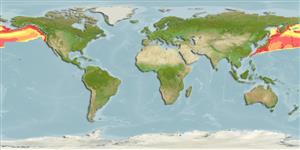>
Argentiniformes (Marine smelts) >
Bathylagidae (Deep-sea smelts)
Etymology: schmidti: Named after P.J. Schmidt, USSR ichthyologist (Ref. 6885).
Eponymy: Dr Petr Yulievich (Julievich) Schmidt (1872–1949) was a Soviet Russian ichthyologist who described a great many fish taxa. [...] (Ref. 128868), visit book page.
Environment: milieu / climate zone / depth range / distribution range
Ecologia
marino batipelagico; distribuzione batimetrica 394 - 1800 m (Ref. 6793). Deep-water; 61°N -
North Pacific: southeastern Hokkaido, Japan to Navarin Canyon in the Bering Sea and southern British Columbia, Canada. Possibly in Kamchatka (Ref. 6885). Regarded as a subspecies of Leuroglossus stilbius, Gilbert 1890 but Peden (1981) presented evidence for separating the two and Dunn (1983) placed them in the genus Leuroglossus.
Size / Peso / Age
Maturity: Lm ? range ? - ? cm
Max length : 20.0 cm SL maschio/sesso non determinato; (Ref. 96339)
Short description
Chiavi di identificazione | Morfologia | Morfometria
Spine dorsali (totale) : 0; Raggi dorsali molli (totale) : 10 - 11; Spine anali: 0; Raggi anali molli: 11 - 14; Vertebre: 47 - 52. Body slender and compressed. Anal fin base short, and almost equal to dorsal fin base. snout pointed. Eye diameter shorter than snout length. Upper jaw shorter than lower jaw. Teeth present on lower jaw, prevomer, palatine, but not on upper jaw. Branchiostegals, 2. Color silvery, dusky on dorsal surface and fins (Ref. 6885).
Adults are generally found at depths greater than 150 m during the day. Oviparous, with planktonic eggs and larvae (Ref. 35604), which are distributed in the sub-arctic gyre south to about 47°N (Ref. 6848).
Allen, M.J. and G.B. Smith, 1988. Atlas and zoogeography of common fishes in the Bering Sea and northeastern Pacific. NOAA Tech. Rep. NMFS 66, 151 p. (Ref. 6793)
IUCN Red List Status (Ref. 130435: Version 2024-1)
Threat to humans
Harmless
Human uses
Pesca: di nessun interesse
Strumenti
Special reports
Download XML
Fonti Internet
Estimates based on models
Preferred temperature (Ref.
123201): 2 - 4.7, mean 3.1 °C (based on 151 cells).
Phylogenetic diversity index (Ref.
82804): PD
50 = 0.6250 [Uniqueness, from 0.5 = low to 2.0 = high].
Bayesian length-weight: a=0.00617 (0.00319 - 0.01192), b=2.96 (2.79 - 3.13), in cm total length, based on LWR estimates for this species & (Sub)family-body (Ref.
93245).
Trophic level (Ref.
69278): 3.1 ±0.0 se; based on diet studies.
Resilienza (Ref.
120179): Medio, tempo minimo di raddoppiamento della popolazione 1.4 - 4.4 anni (Preliminary K or Fecundity.).
Fishing Vulnerability (Ref.
59153): Low vulnerability (14 of 100).
